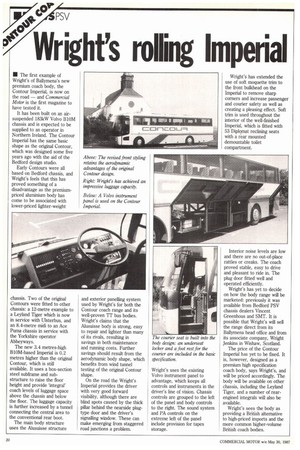Wright's rolling Imperial
Page 22

If you've noticed an error in this article please click here to report it so we can fix it.
• The first example of Wright's of Ballymena's new premium coach body, the Contour Imperial, is now on the road — and Commercial Motor is the first magazine to have tested it.
It has been built on an airsuspended 183kW Volvo B1OM chassis and is expected to be supplied to an operator in Northern Ireland. The Contour Imperial has the same basic shape as the original Contour, which was designed some five years ago with the aid of the Bedford design studio.
Early Contours were all based on Bedford chassis, and Wright's feels that this has proved something of a disadvantage as the premiumpriced aluminium body has come to be associated with lower-priced lighter-weight chassis. Two of the original Contours were fitted to other chassis: a 12-metre example to a Leyland Tiger which is now in service with Ulsterbus, and an 8.4-metre midi to an Ace Puma chassis in service with the Yorkshire operator Abbeyways.
The new 3.4 metres-high BlOM-based Imperial is 0.2 metres higher than the origami Contour, which is still available. It uses a box-section steel subframe and substructure to raise the floor height and provide 'integral' coach levels of luggage space above the chassis and below the floor. The luggage capacity is further increased by a tunnel connecting the central area to the conventional rear boot.
The main body structure uses the Alusuisse structure and exterior panelling system used by Wright's for both the Contour coach range and its well-proven TT bus bodies. Wright's claims that the Alusuisse body is strong, easy to repair and lighter than many of its rivals, resulting in savings in both maintenance and running costs. Further savings should result from the aerodynamic body shape, which benefits from wind tunnel testing of the original Contour shape.
On the road the Wright's Imperial provides the driver with very good forward visibility, although there are blind spots caused by the thick pillar behind the nearside plugtype door and the driver's signalling window. These can make emerging from staggered road junctions a problem. Wright's uses the existing Volvo instrument panel to advantage, which keeps all controls and instruments in the driver's line of vision. Chassis controls are grouped to the left of the panel and body controls to the right. The sound system and PA controls on the extreme left of the panel include provision for tapes storage. Wright's has extended the use of soft moquette trim to the front bulkhead on the Imperial to remove sharp corners and increase passenger and courier safety as well as creating a pleasing effect. Soft trim is used throughout the interior of the well-finished Imperial, which is fitted with 53 Diplomat reclining seats with a rear mounted demountable toilet compartment.
Interior noise levels are low and there are no out-of-place rattles or creaks. The coach proved stable, easy to drive and pleasant to ride in. The plug door fitted well and operated efficiently.
Wright's has yet to decide on how the body range will be marketed: previously it was available from Bedford PSV chassis dealers Vincent Greenhous and SMT. It is possible that Wright's will sell the range direct from its Ballymena head office and from its associate company, Wright Jenkins in Wishaw, Scotland.
The price of the Contour Imperial has yet to be fixed. It is, however, designed as a premium high specification coach body, says Wright's, and will be priced accordingly. The body will be available on other chassis, including the Leyland Tiger, and a number of rearengined integrals will also be available.
Wright's sees the body as providing a British alternative to high-priced imports and the more common higher-volume British coach bodies.












































































